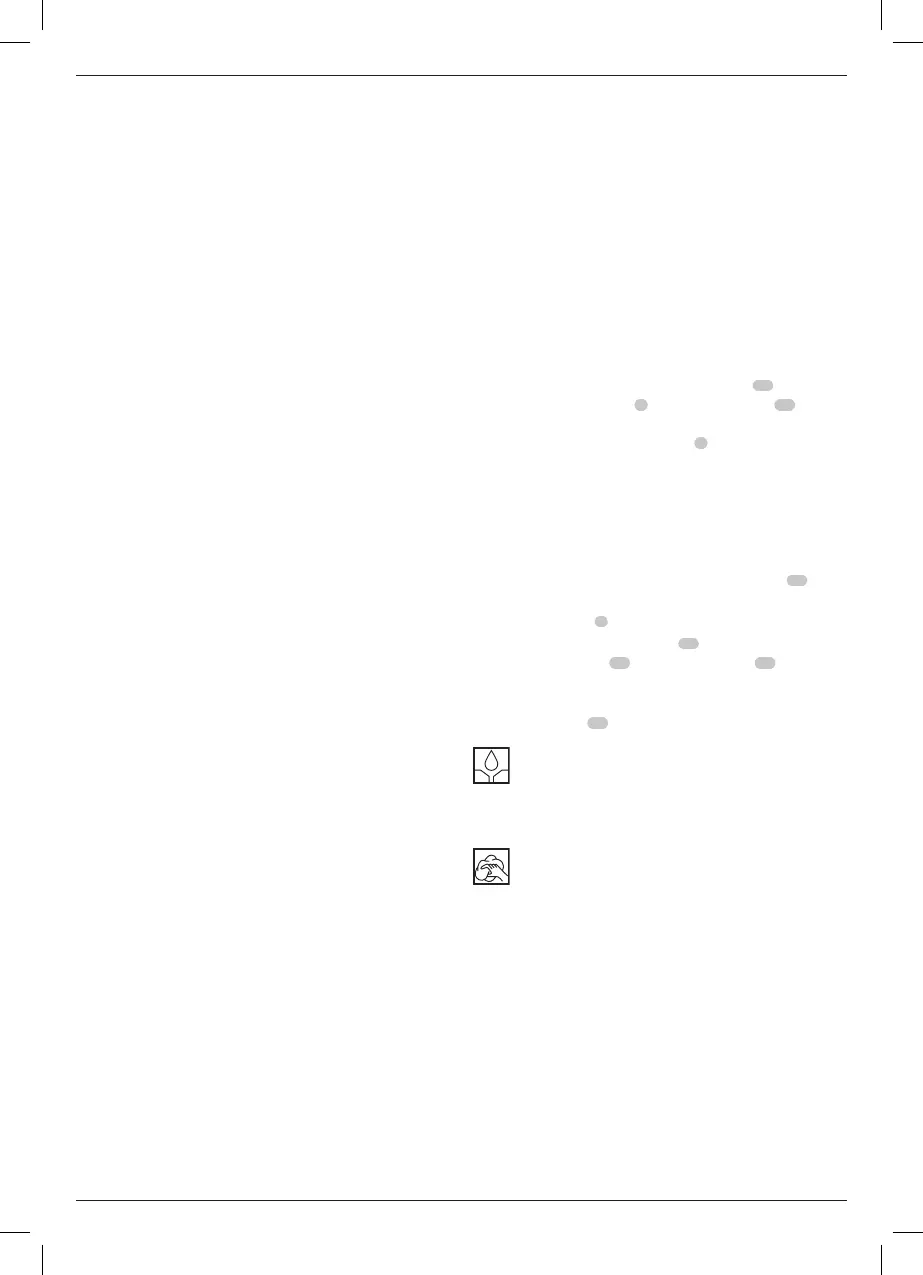11
ENGLISH
Cleaning
WARNING: Blow dirt and dust out of the main housing
with dry air as often as dirt is seen collecting in and around
the air vents. Wear approved eye protection and approved
dust mask when performing thisprocedure.
WARNING: Never use solvents or other harsh chemicals
for cleaning the non-metallic parts of the tool. These
chemicals may weaken the materials used in these parts.
Use a cloth dampened only with water and mild soap.
Never let any liquid get inside the tool; never immerse any
part of the tool into aliquid.
Lubrication
Your power tool requires no additionallubrication.
Replacing the Sanding Pad and the Belt
(Fig.G)
Your sander is equipped with a replaceable belt
13
which
is located between the pad
6
and the sander body
12
. It is
designed to control the pad speed while the unit is off the work
surface. The belt and the sanding pad
6
are designed to be
consumable parts and will occasionally need to be replaced. The
sanding pad needs replacement when signs of wear become
evident. Replacement of the belt is necessary when the pad
speed increases very dramatically when the unit is lifted from
the work surface. These parts are available at extra cost from
your local dealer or authorised
servicecentre.
1. Holding the platen firmly, remove the four screws
14
from
the bottom of thepad.
2. Remove the pad
6
.
3. Replace worn or damaged belt
13
by wrapping it around
the shoulder screw
15
and bearing retainer
16
as shown
in FigureG.
4. Reinstall pad (replace with new pad if necessary). Replace
the four screws
14
. Be careful not to over-tightenscrews.
MAINTENANCE
Your power tool has been designed to operate over a long
period of time with a minimum of maintenance. Continuous
satisfactory operation depends upon proper tool care and
regularcleaning.
WARNING: To reduce the risk of serious personal
injury, turn tool off and disconnect battery pack
before making any adjustments or removing/
installing attachments or accessories. An accidental
start-up can causeinjury.
The charger and battery pack are notserviceable.
and change gradually to finer and finer paper. Vacuum and
wipe surface with a tack cloth between grit steps. Your sander is
designed to sand into small or confined areas. Its small size and
light weight make it ideal for overheadwork.
The rate at which the dust collection bag fills up will vary with
the type of material being sanded and the coarseness of the
sandpaper. For best results, empty the bag frequently. When
sanding painted surfaces, (see the following for additional
precautions when sanding paint) you may find that the
sandpaper loads up and clogs with paint. A heat gun will work
much better to remove paint before sanding. FOLLOW ALL
SAFETY INSTRUCTIONS IN HEAT GUN INSTRUCTIONMANUAL.
Precautions to Take When Sanding Paint
Sanding of lead based paint is NOT RECOMMENDED due to the
difficulty of controlling the contaminated dust. The greatest
danger of lead poisoning is to children and pregnantwomen.
Since it is difficult to identify whether or not a paint contains
lead without a chemical analysis, we recommend the following
precautions when sanding any paint:
1. PERSONAL SAFETY
- No children or pregnant women should enter the work
area where the paint sanding is being done until all
clean up iscompleted.
- A dust mask or respirator should be worn by all persons
entering the work area. The filter should be replaced
daily or whenever the wearer has difficulty breathing.
See your local hardware store for the proper NIOSH-
approved dustmask.
- NO EATING, DRINKING or SMOKING should be done in
the work area to prevent ingesting contaminated paint
particles. Workers should wash and clean up BEFORE
eating, drinking or smoking. Articles of food, drink, or
smoking should not be left in the work area where dust
would settle onthem.
2. ENVIRONMENTAL SAFETY
- Paint should be removed in such a manner as to
minimize the amount of dustgenerated.
- Areas where paint removal is occurring should be sealed
with plastic sheeting of 4 milsthickness.
- Sanding should be done in a manner to reduce tracking
of paint dust outside the workarea.
3. CLEANING AND DISPOSAL
- All surfaces in the work area should be vacuumed
and thoroughly cleaned daily for the duration of
the sanding project. Vacuum filter bags should be
changedfrequently.
- Plastic drop cloths should be gathered up and disposed
of along with any dust chips or other removal debris.
They should be placed in sealed refuse receptacles and
disposed of through regular trash pick-up procedures.
During clean up, children and pregnant women should
be kept away from the immediate workarea.
- All toys, washable furniture and utensils used by
children should be washed thoroughly before being
usedagain.

